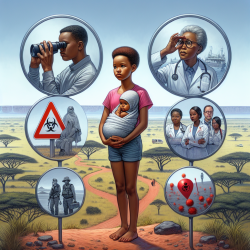Introduction
As a practitioner in the field of education and therapy, understanding the intricate dynamics between early adolescent pregnancy and subsequent health risks is crucial. The research article titled Early adolescent pregnancy increases risk of incident HIV infection in the Eastern Cape, South Africa: a longitudinal study provides valuable insights into how early pregnancies can increase the risk of HIV infection among young women. This blog aims to summarize the key findings of the study and suggest ways practitioners can implement these outcomes to improve their skills and knowledge.
Key Findings
The study conducted in the Eastern Cape of South Africa revealed that young women who experienced pregnancy at age 15 or younger were three times more likely to acquire HIV compared to those who did not have an adolescent pregnancy. The research identified that this increased risk was associated with behavioral factors, such as having multiple sexual partners and a significant age difference with partners, rather than biological factors like hormonal changes during pregnancy.
Additionally, the study highlighted that early adolescent pregnancies were often linked with higher instances of sexual risk behaviors, including inconsistent condom use and transactional sex. These behaviors further contributed to the increased risk of HIV infection.
Implications for Practitioners
For practitioners working with adolescents, these findings underscore the importance of addressing early adolescent pregnancy as a critical factor in HIV prevention strategies. Here are some actionable steps practitioners can take:
- Education and Awareness: Implement educational programs that focus on the risks associated with early pregnancies and the importance of safe sexual practices. These programs should be tailored to address the cultural and social contexts of the adolescents.
- Promote Gender Equality and Sexual Rights: Encourage discussions around gender equality and empower young women to make informed decisions about their sexual health. This includes advocating for delayed sexual debut and promoting the use of contraceptives.
- Collaborate with Healthcare Providers: Work closely with healthcare providers to ensure adolescents have access to confidential and non-judgmental sexual health services. This collaboration can help address the barriers adolescents face in accessing contraceptives and other preventive measures.
- Supportive Interventions: Develop interventions that focus on reducing the number of sexual partners and addressing intimate partner violence. These interventions should be culturally sensitive and involve community stakeholders.
Encouraging Further Research
While this study provides significant insights, further research is needed to explore the pathways through which early adolescent pregnancy increases the risk of HIV infection. Practitioners are encouraged to engage in or support research initiatives that investigate these complex relationships and contribute to the development of effective prevention strategies.
Conclusion
Understanding the link between early adolescent pregnancy and HIV risk is essential for developing comprehensive prevention strategies. By implementing the findings of this study, practitioners can play a pivotal role in reducing the incidence of HIV among young women in high-prevalence areas. To read the original research paper, please follow this link: Early adolescent pregnancy increases risk of incident HIV infection in the Eastern Cape, South Africa: a longitudinal study.










